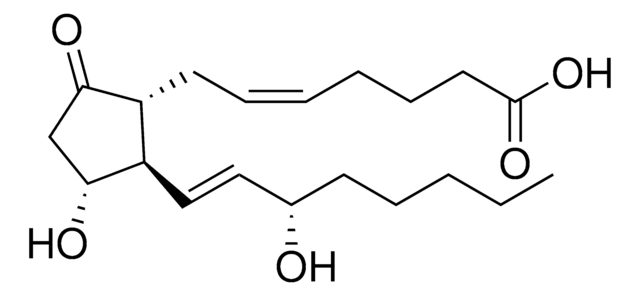L5011
Leukotriene D4
~50 μg/mL (in methanol/ammonium acetate buffer, 70:30, pH 5.6), ≥97%
Synonym(s):
LTD4
About This Item
Recommended Products
Quality Level
Assay
≥97%
concentration
~50 μg/mL (in methanol/ammonium acetate buffer, 70:30, pH 5.6)
shipped in
dry ice
storage temp.
−70°C
SMILES string
CCCCC\C=C\C/C=C\C=C\C=C\[C@@H](SC[C@@H](N)C(=O)NCC(O)=O)[C@@H](O)CCCC(O)=O
InChI
1S/C25H40N2O6S/c1-2-3-4-5-6-7-8-9-10-11-12-13-16-22(21(28)15-14-17-23(29)30)34-19-20(26)25(33)27-18-24(31)32/h6-7,9-13,16,20-22,28H,2-5,8,14-15,17-19,26H2,1H3,(H,27,33)(H,29,30)(H,31,32)/b7-6+,10-9-,12-11+,16-13+/t20-,21+,22-/m1/s1
InChI key
YEESKJGWJFYOOK-GKWRKXFUSA-N
Biochem/physiol Actions
Features and Benefits
Packaging
Signal Word
Danger
Hazard Statements
Precautionary Statements
Hazard Classifications
Acute Tox. 3 Dermal - Acute Tox. 3 Inhalation - Acute Tox. 3 Oral - Flam. Liq. 2 - STOT SE 1
Target Organs
Eyes
Storage Class Code
3 - Flammable liquids
WGK
WGK 3
Flash Point(F)
49.5 °F
Flash Point(C)
9.7 °C
Personal Protective Equipment
Certificates of Analysis (COA)
Search for Certificates of Analysis (COA) by entering the products Lot/Batch Number. Lot and Batch Numbers can be found on a product’s label following the words ‘Lot’ or ‘Batch’.
Already Own This Product?
Find documentation for the products that you have recently purchased in the Document Library.
Our team of scientists has experience in all areas of research including Life Science, Material Science, Chemical Synthesis, Chromatography, Analytical and many others.
Contact Technical Service








